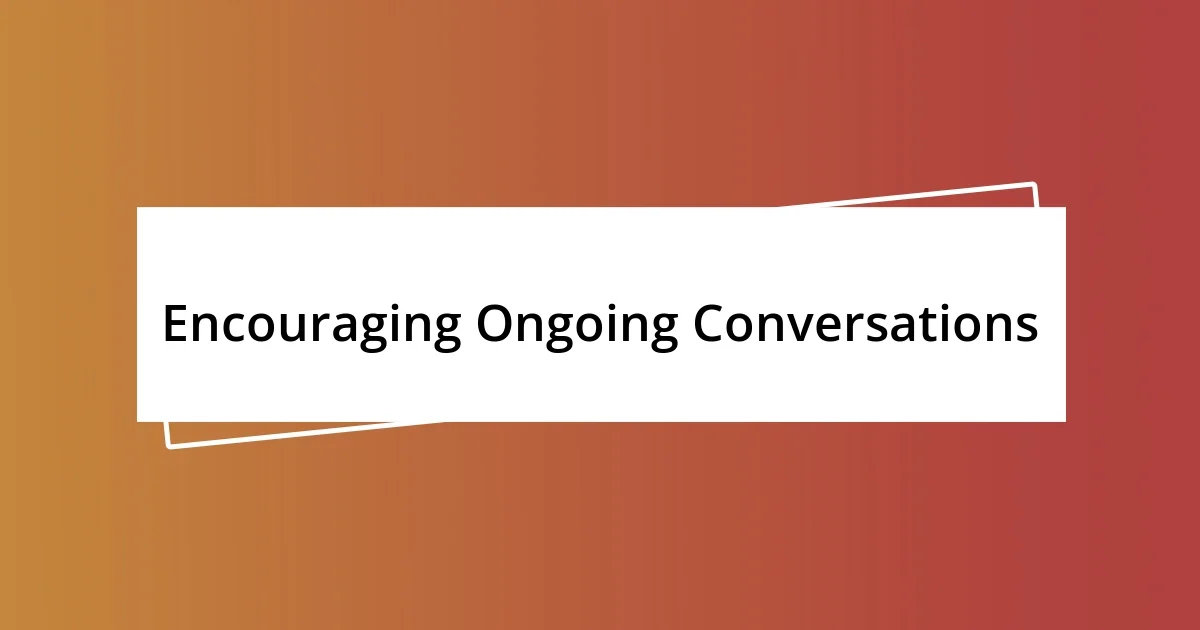Key takeaways:
- Creating a comfortable and trusting environment encourages elderly individuals to engage in meaningful health conversations, fostering openness and emotional connection.
- Utilizing relatable anecdotes and simplifying complex information enhances understanding and participation in health discussions among the elderly.
- Ongoing conversations about health, interwoven with personal interests, build trust and empower older adults to take proactive steps towards their well-being.

Understanding the Importance of Engagement
Engagement in health conversations isn’t just about sharing information; it’s about fostering trust. I remember a touching moment when I sat down with an elderly neighbor, who’d been hesitant to discuss her health. As we sipped tea, her walls came down, and we talked openly about her challenges. It struck me how vital it is to create a comfortable environment where they feel heard and valued.
When I reflect on the times I’ve navigated health discussions with older adults, I often ask myself: why do some people shut down? I’ve learned that engagement often hinges on the emotional connection we build. It’s not merely about facts; it’s about empathy and understanding. I’ve found that sharing relevant anecdotes from my own life can resonate with them, making the conversation feel more personal and relatable.
Moreover, consider this: how can we expect them to be proactive about their health if they feel isolated? I’ve seen firsthand the barriers that arise when elderly individuals shy away from conversations. When they feel involved, it empowers them, leading to better health outcomes. For instance, encouraging them to share their experiences creates an inclusive dialogue that can demystify health issues.

Identifying Key Health Topics
Identifying key health topics to discuss with the elderly can feel daunting at first, but I’ve learned that it greatly varies based on individual interests and needs. I often start by asking open-ended questions about their experiences or concerns. For instance, during a recent chat with a retired nurse, we explored her thoughts on managing chronic pain, which revealed a wealth of information and insights she had. This not only guided our conversation but also made her feel more engaged as she shared her expertise and personal strategies.
When I create a list of potential health topics, I focus on areas that resonate deeply with the elderly, such as medication management, nutrition, and social interaction. I’ve found that discussing these topics leads to enlightening narratives and shared experiences that can benefit everyone involved. Once, while exchanging recipes with an elderly friend, we stumbled into a meaningful discussion about dietary changes in her family over the years. Our laughter and the sharing of stories highlighted the significance of nutrition, making it a comfortable and enjoyable conversation.
Another effective method I’ve adopted is to stay attuned to their body language and emotional responses. This real-time feedback helps me pivot towards subjects that evoke passion or concern. For example, I noticed a friend light up when I mentioned gardening, which opened the door to discussing the benefits of physical activity and mental health. Engaging them in conversations linked directly to their interests not only strengthens our bond but also empowers them to be more proactive about their health.
| Health Topic | Why It’s Relevant |
|---|---|
| Medication Management | Helps prevent adverse interactions and ensures they understand their prescriptions. |
| Nutrition | Addresses dietary needs and how they can influence overall well-being. |
| Social Interaction | Promotes mental health and reduces feelings of loneliness. |

Creating a Comfortable Environment
Creating a comfortable environment is essential for fruitful health conversations with the elderly. I remember meeting with my grandmother in her cozy living room—her favorite armchair was worn in just the right places, and the soft light streaming through the window made everything feel warm and inviting. It was in this comfort that she shared her fears about managing her medications. That experience reinforced my belief that physical surroundings impact emotional safety.
To foster this kind of environment, here are some key considerations:
- Choose a familiar and inviting space: A place where they feel at ease, like their home, encourages openness.
- Minimize distractions: Turn off the TV and put away phones to show that you’re fully engaged.
- Use empathetic body language: Offer warm smiles and maintain eye contact to convey your presence.
- Listen actively: Nodding and responding to their thoughts shows you are truly involved in the conversation.
- Adjust the environment: Ensure the room is well-lit and at a comfortable temperature to eliminate discomfort while talking.
By focusing on these elements, I’ve found that conversations flowed more naturally, enabling meaningful exchanges that pave the way for better health discussions.

Using Effective Communication Techniques
One of the most effective communication techniques I’ve employed is actively listening. During a conversation, I’ve often noticed that the elderly appreciate when I mirror their emotions. Just the other day, while chatting with a friend’s grandmother, I picked up on her anxiety about a recent diagnosis. Instead of moving forward with my agenda, I paused and acknowledged her feelings. “It sounds like this is really weighing on you,” I said. This small shift in my approach opened up a deeper dialogue where she expressed her fears and expectations, transforming what could have been a one-sided discussion into a meaningful exchange.
Another tactic I find beneficial is to simplify complex health information into digestible bits. For instance, when talking about heart health, I focus on a few key points rather than overwhelming them with medical terminology. Instead of saying, “You should monitor your cholesterol levels,” I might say, “Let’s chat about how eating different foods can help keep your heart happy.” This not only clarifies the message but also invites them to share their favorite recipes or thoughts related to the topic. It creates a collaborative atmosphere, making them feel part of the conversation rather than just a recipient of information.
I also strive to use relatable examples that resonate with their life experiences. During a recent discussion about diabetes, I shared a simple story about my own family members managing the condition. “My uncle found that cutting back on sugary snacks really helped his energy,” I told her. It seems to spark interest and curiosity, prompting her to consider her own habits. This personal touch not only breaks the ice but solidifies a connection that pervades our health conversations. Isn’t it fascinating how a little relatability can foster deeper understanding?

Incorporating Technology in Discussions
When I first introduced technology into conversations with my elder relatives, I was surprised by how engaged they became. I remember one afternoon, I set up a simple video call with my uncle to discuss his recent health check-up. At first, he was skeptical, unsure if he wanted to navigate this new technology. However, once we got started, I could see his curiosity spark as he viewed images of new health apps on my phone. It was like flipping a switch; the excitement in his voice was palpable as he began to explore options for tracking his medications.
Using technology didn’t just enhance our discussions; it also empowered them. For instance, I introduced my aunt to a health monitoring device that tracks her steps. Watching her delight as she connected it to her smartphone was heartwarming. We spent hours discussing her daily goals and how reaching them could lead to improved health. I found that technology served as a bridge, enabling her to take ownership of her health in ways that felt exciting rather than overwhelming. How incredible is it that a small gadget could spark such joy and motivation?
I often wonder, how can we integrate technology without making it feel intrusive? A gentle approach seems to work best. I focus on sharing resources that are user-friendly—like simple health apps that feature large buttons and clear instructions. When I showed my neighbor how to use an app designed for medication reminders, she was initially hesitant. Yet, as soon as I guided her through setting it up, her face lit up with relief and gratitude. It’s moments like these that remind me how accessible technology can genuinely enrich our discussions when used thoughtfully.

Encouraging Ongoing Conversations
Encouraging ongoing conversations with the elderly is a practice I cherish. I recall a particularly enlightening afternoon spent with my great-aunt as we discussed her health goals. Rather than treating our chat as a one-off event, I made it a habit to check in regularly about her progress. Each time I did, her eyes would light up as she shared her little victories and challenges. Questions like, “How’s that new walking routine coming along?” can transform a simple inquiry into a pathway for deeper engagement.
What I found powerful is weaving health topics into everyday conversations. One day, while sharing lunch, I casually brought up the benefits of staying hydrated. It sparked a delightful exchange when I learned my aunt had a secret fondness for herbal teas. Instead of steering the conversation solely towards health, I embraced her passion and asked, “What’s your favorite blend?” This not only kept the dialogue flowing but also made health discussions feel natural and enjoyable. Isn’t it amazing how blending personal interests can lead to relatable health conversations?
I also believe in setting the stage for these exchanges by creating an open environment. When I invited my elderly neighbor over for tea, I made sure to keep the atmosphere light and inviting. During our chat, I encouraged her to express any health-related concerns she had. Her initial hesitance faded, and she began sharing stories about her past experiences with doctors. With each memory she shared, I noticed her growing more comfortable expressing her feelings about aging. It was a gentle reminder that sometimes, all it takes is a warm cup of tea and a listening ear to nurture trust in ongoing health conversations.

Evaluating the Impact of Engagement
Evaluating the impact of engagement reveals profound insights. I recall a recent visit with my grandfather, where I encouraged him to reflect on how our discussions made him feel. He candidly expressed that talking about his health openly helped him feel less isolated and more in control. This moment struck me as a testimony to the real benefits of engaging, not just the facts and figures.
During another conversation with a family friend, we delved deeper into her health journey, exploring past struggles and victories with candor. She told me that engaging in our conversations made her feel heard and valued, which inspired her to take proactive steps towards her wellness. It made me realize that the emotional weight of these dialogues can sometimes outweigh the actual information shared—they foster a sense of community and encouragement, don’t they?
Moreover, I’ve noticed that quantifying engagement can sometimes dilute its essence. For instance, we often measure success by the frequency of discussions or the adoption of health practices. Yet, I’ve found that the quality of these conversations often holds more significance. The trust established through meaningful interactions can ignite motivation and accountability in ways numbers simply can’t capture. Isn’t it intriguing how personal connections can truly transform one’s health journey?














